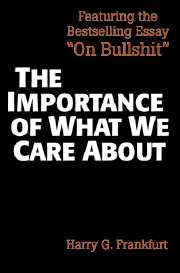Book contents
- Frontmatter
- Contents
- Preface
- Sources
- 1 Alternate possibilities and moral responsibility
- 2 Freedom of the will and the concept of a person
- 3 Coercion and moral responsibility
- 4 Three concepts of free action
- 5 Identification and externality
- 6 The problem of action
- 7 The importance of what we care about
- 8 What we are morally responsible for
- 9 Necessity and desire
- 10 On bullshit
- 11 Equality as a moral ideal
- 12 Identification and wholeheartedness
- 13 Rationality and the unthinkable
5 - Identification and externality
Published online by Cambridge University Press: 05 June 2012
- Frontmatter
- Contents
- Preface
- Sources
- 1 Alternate possibilities and moral responsibility
- 2 Freedom of the will and the concept of a person
- 3 Coercion and moral responsibility
- 4 Three concepts of free action
- 5 Identification and externality
- 6 The problem of action
- 7 The importance of what we care about
- 8 What we are morally responsible for
- 9 Necessity and desire
- 10 On bullshit
- 11 Equality as a moral ideal
- 12 Identification and wholeheartedness
- 13 Rationality and the unthinkable
Summary
One of the central and most difficult problems in the theory of action is often formulated in some such way as the following. What account is to be given of the difference between the sort of thing that goes on when a person raises his arm (say, to give a signal) and the sort of thing that happens when a person's arm rises (say, because of a muscular spasm) without his raising it? The question invokes a contrast between events that are actions, in which the higher faculties of human beings come into play, and those movements of a person's body – instances of behavior other than actions, or mere bodily happenings – that he does not himself make. This contrast can evidently be generalized. It is a special case of the contrast between activity and passivity, which is considerably wider in scope.
Actions are instances of activity, though not the only ones even in human life. To drum one's fingers on the table, altogether idly and inattentively, is surely not a case of passivity: the movements in question do not occur without one's making them. Neither is it an instance of action, however, but only of being active. The occurrence in human life of events that are neither actions nor mere happenings is sometimes overlooked, but it should not be surprising.
- Type
- Chapter
- Information
- The Importance of What We Care AboutPhilosophical Essays, pp. 58 - 68Publisher: Cambridge University PressPrint publication year: 1988
- 35
- Cited by

